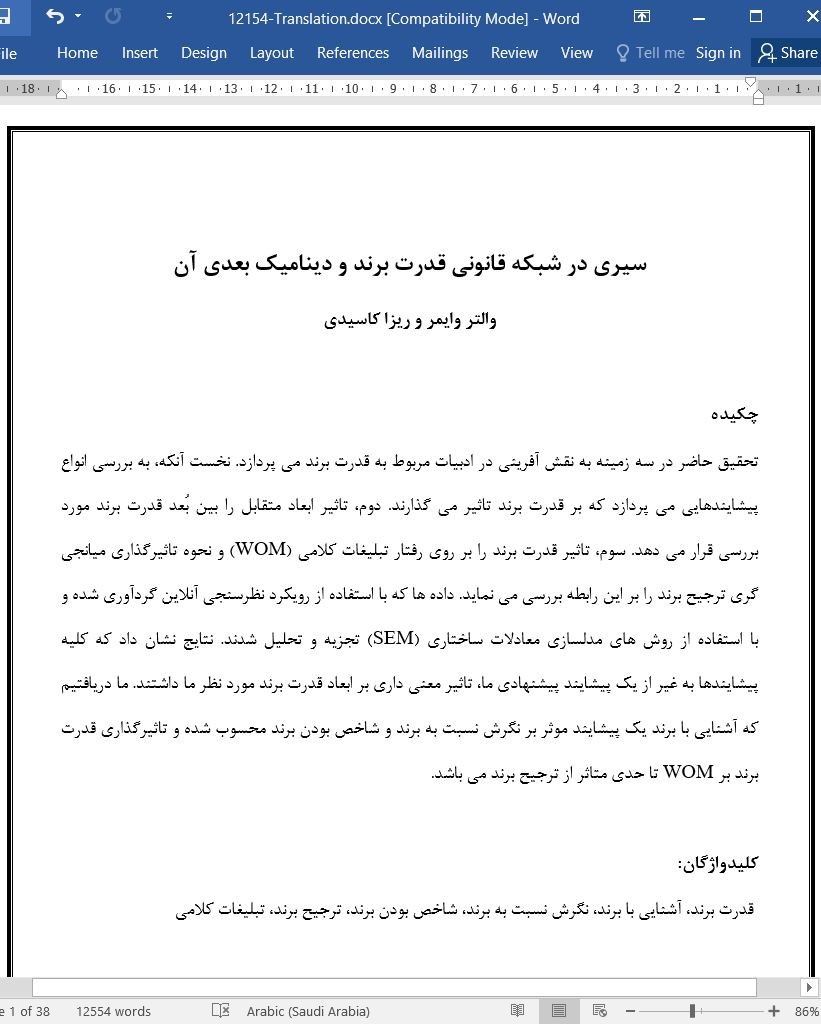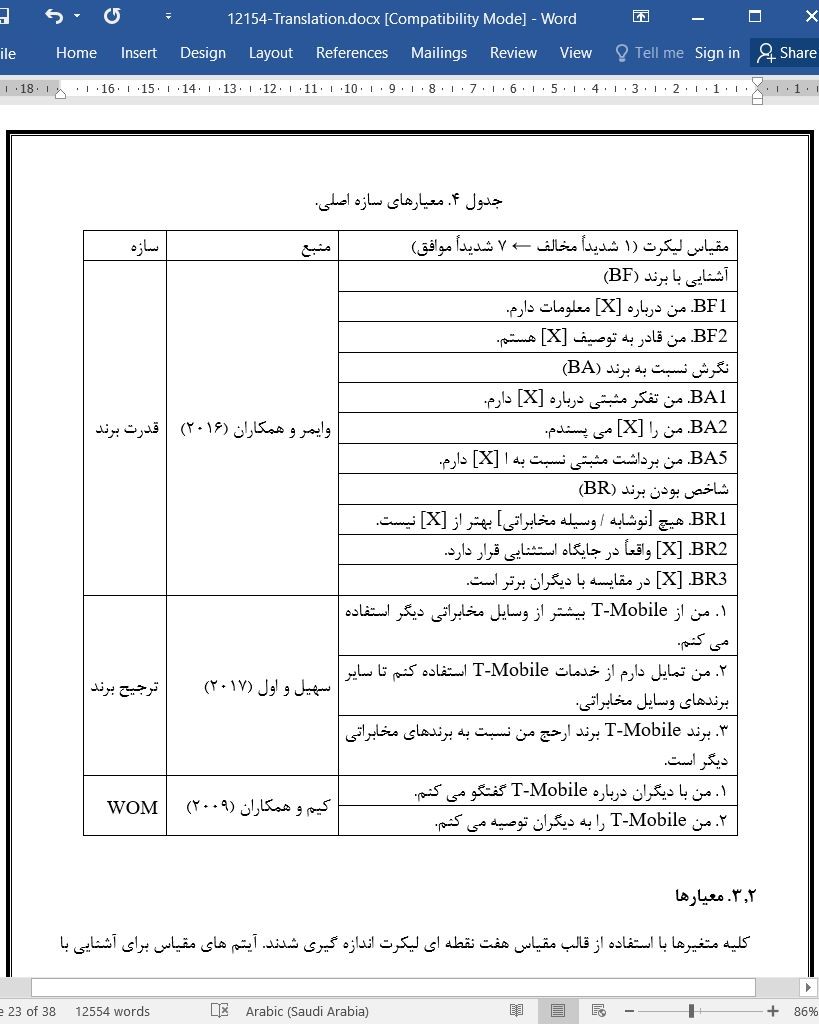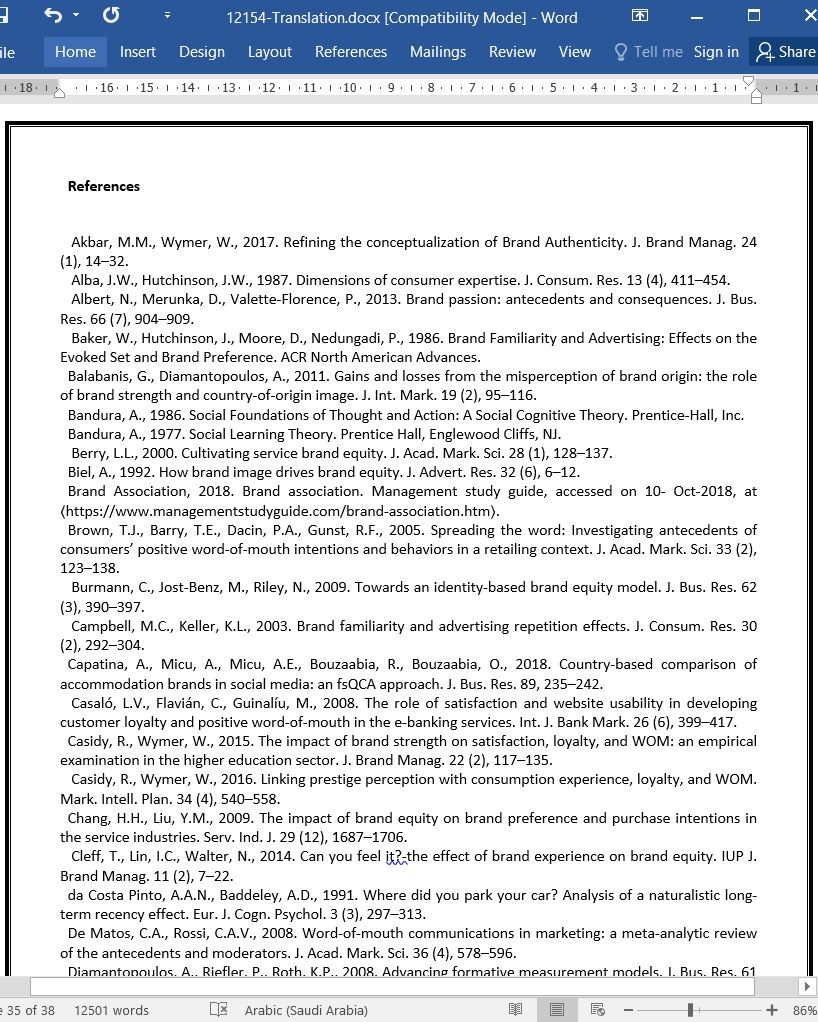
سیری در شبکه قانونی قدرت برند و دینامیک بعدی آن
چکیده
تحقیق حاضر در سه زمینه به نقش آفرینی در ادبیات مربوط به قدرت برند می پردازد. نخست آنکه، به بررسی انواع پیشایندهایی می پردازد که بر قدرت برند تاثیر می گذارند. دوم، تاثیر ابعاد متقابل را بین بُعد قدرت برند مورد بررسی قرار می دهد. سوم، تاثیر قدرت برند را بر روی رفتار تبلیغات کلامی (WOM) و نحوه تاثیرگذاری میانجی گری ترجیح برند را بر این رابطه بررسی می نماید. داده ها که با استفاده از رویکرد نظرسنجی آنلاین گردآوری شده و با استفاده از روش های مدلسازی معادلات ساختاری (SEM) تجزیه و تحلیل شدند. نتایج نشان داد که کلیه پیشایندها به غیر از یک پیشایند پیشنهادی ما، تاثیر معنی داری بر ابعاد قدرت برند مورد نظر ما داشتند. ما دریافتیم که آشنایی با برند یک پیشایند موثر بر نگرش نسبت به برند و شاخص بودن برند محسوب شده و تاثیرگذاری قدرت برند بر WOM تا حدی متاثر از ترجیح برند می باشد.
1. مقدمه
توجه فزاینده ای به تحقیقات درباره قدرت برند وجود دارد (کاپاتینا و همکاران، ۲۰۱۸؛ دیواکاران، ۲۰۱۸؛ لین و همکاران، ۲۰۱۸؛ نایدو و آبرات، ۲۰۱۸؛ وایدمان و همکاران، ۲۰۱۸). این یک باور عمومی است که برندهای قوی به نتایج مد نظر همچون: افزایش فروش، افزایش وفاداری به برند، سهم بازار بیشتر، و افزایش ارزش ویژه برند منتهی می شوند (کلر، ۲۰۰۳).
اغلب تحقیقات پیشین که به قدرت برند پرداخته بودند نوعاً قدرت برند را به عنوان یک تعدیل کننده دوگانه برشمردند. قدرت برند به عنوان یک متغیر پیوسته اندازه گیری نمی گردد. بلکه، محققان عموماً دو برند صنعتی را (ضعیف در برابر قوی) را بر مبنای فروش یا معیارهای مشابه مشخص نموده اند (گلین، ۲۰۱۰؛ هو – داک و همکاران، ۲۰۱۳؛ لین و همکاران، ۲۰۱۸؛ تسائو و همکاران، ۲۰۱۸). محققان از نمونه برندهای قوی در برابر برندهای ضعیف به منظور بررسی تاثیرگذاری تعدیل کننده قدرت برند دو مقوله ای بر روابط اصلی پیشایندها - پیامدها در مطالعات استفاده نمودند.
4.3. محدودیت ها و جهت گیری های تحقیقات آتی
کلیه تحقیقات لزوماً دارای محدودیت هایی هستند. ما داده های مقطعی را از روی پنل های نظرسنجی آمریکا گردآوری نمودیم. از این رو، تفسیر و کاربرد یافته های ما در زمینه های دیگر، باید با توجه به محدودیت های این اثر با ملاحظاتی صورت پذیرد. مطالعات آتی می توانند روایی مدل ما را با تکنیک های دیگری مانند طرح آزمایشی و یا تجزیه و تحلیل داده های ثانویه مورد آزمایش قرار دهند. پیوند برداشت نسبت به قدرت برند با داده های فروش واقعی و رفتار WOM یافته های ما را بیشتر تقویت می کنند.
Abstract
This research makes three contributions to the literature on brand strength. First, it examines a variety of antecedents that influence brand strength. Second, it investigates the inter-dimensional influences among brand strength's three dimensions. Third, it examines the influence of brand strength on word-of-mouth (WOM) behavior, and how brand preference mediation influences this relationship. Data were collected using an online survey approach and analyzed using structural equation modeling (SEM) methods. The results reveal that all but one of our proposed antecedents had a significant influence on our target brand strength dimensions. We found that brand familiarity has an antecedent influence on brand attitude and brand remarkability, and that the influence of brand strength on WOM is partially mediated by brand preference.
1. Introduction
There has been an increased interest with respect to research comprising brand strength (Capatina et al., 2018; Divakaran, 2018; Lin et al., 2018; Naidoo and Abratt, 2018; Wiedmann et al., 2018). It is a common assumption that strong brands lead to desired outcomes such as increased sales, increased brand loyalty, greater market share, and increased brand equity (Keller, 2003).
Most prior research which included brand strength in the investigation typically positioned brand strength as a dichotomous moderator. Brand strength was not measured as a continuous variable. Instead, investigators generally identified two industry brands (weak vs strong) based on sales or similar criteria (Glynn, 2010; Ho-Dac et al., 2013; Lin et al., 2018; Tsao et al., 2018). Researchers used examples of strong versus weak brands to examine the influence of a two-category brand strength moderator on the focal antecedent-consequent relationships under investigation.
4.3. Limitations and future research directions
All research by necessity has limitations. We collected cross-sectional data from U.S. survey panels. Hence, interpretations of our findings and the application of our findings to other contexts should be done with due consideration, given the limitations of this work. Future studies could test the validity of our model using other techniques such as experimental design or secondary data analysis. Linking brand strength perceptions to actual sales data and WOM behavior would further strengthen our findings.
چکیده
1. مقدمه
2. نظریه و توسعه فرضیات
2.1 قدرت برند وارزش ویژه برند
2.2 شبکه قانونی
2.3 پیشایندهای آشنایی با برند
2.4 پیشایندهای نگرش نسبت به برند
2.5 پیشایندهای شاخص بودن برند
2.6 دینامیک های بین بعدی قدرت برند
2.7 رفتارWOM
2.8 ترجیح برند به عنوان یک میانجی
3. مطالعات تجربی
3.1 نمونه
3.2 معیارها
3.3 مطالعه 1 اطلاح مدل اندازه گیری
3.4 تورش روش مشترک
3.5 مطالعه 2: آزمون فرضیات
4. بحث
4.1 نقش آفرینی های تحقیق حاضر
4.2 پیامدهای عملی
4.3 محدودیت ها و جهت گیری های تحقیقات آتی
منابع
ABSTRACT
1. Introduction
2. Theory and hypotheses development
2.1. Brand strength and brand equity
2.2. Nomological net
2.3. Antecedents of brand familiarity
2.4. Antecedents of brand attitude
2.5. Antecedents of brand remarkability
2.6. Inter-dimensional dynamics of brand strength
2.7. WOM behavior
2.8. Brand preference as a mediator
3. Empirical studies
3.1. Sample
3.2. Measures
3.3. Study 1: measurement model refinement
3.4. Common method bias
3.5. Study 2: hypotheses testing
4. Discussion
4.1. Contributions of this research
4.2. Practical implications
4.3. Limitations and future research directions
References
- اصل مقاله انگلیسی با فرمت ورد (word) با قابلیت ویرایش
- ترجمه فارسی مقاله با فرمت ورد (word) با قابلیت ویرایش، بدون آرم سایت ای ترجمه
- ترجمه فارسی مقاله با فرمت pdf، بدون آرم سایت ای ترجمه



